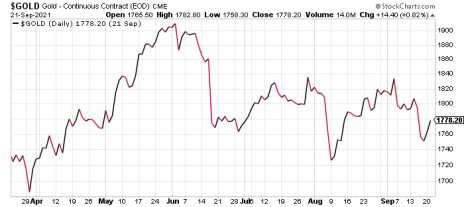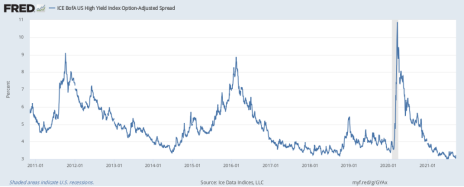Under the recent avalanche of stories relating to Afghanistan, China’s Evergrande debt crisis and the U.S. debt ceiling debate was buried an interesting headline you may have missed. It involves a multi-million-dollar gold purchase by a well-known tech mogul. It also begs the question: Is gold’s breakthrough moment nearly at hand?
A few weeks ago, deep within its 93-page second-quarter earnings report, Palantir Technologies (PLTR), the data analytics software company co-founded and chaired by Peter Thiel of PayPal fame, quietly disclosed it has become a gold investor. Palantir purchased over $50 million of gold in the form of 100-ounce bars during August, raising some eyebrows.
Palantir said of the transaction: “Such purchase will initially be kept in a secure third-party facility located in the northeastern United States and the company is able to take physical possession of the gold bars stored at the facility at any time with reasonable notice.”
[text_ad]
Why Peter Thiel Bought Gold
While there are undoubtedly other reasons behind Palantir’s gold investment decision, the company has made it clear that hedging against financial market uncertainty is one of them. Moreover, Bloomberg has reported that going forward Palantir will accept payment from its software customers in gold.
The firm’s COO, Shyam Sankar, told Bloomberg in regard to the gold purchase: “You have to be prepared for a future with more black swan events,” in reference to unanticipated financial market turmoil that can lead to dire consequences. Obviously, then, Palantir is using gold as a safety hedge against future potential market disruptions.
That such a well-known and respected tech titan as Peter Thiel and company are now associated with gold naturally created a stir among inveterate gold bulls. The message boards of several prominent gold websites lit up with enthused speculation to the effect that gold’s next big “breakout moment” was at hand.
And while gold prices went on to post a 3% rally in the days immediately following the announcement, the excitement was short lived. After peaking at $1,834 an ounce, the rally faded and gold gave back all its gains and then some, falling 5% before finding support at $1,740 an ounce.
This isn’t the first time a celebrated member of the “smart money” crowd has made a publicized gold-related investment. In last year’s Q2, Warren Buffett’s Berkshire Hathaway bought a $564 million stake in publicly traded senior gold miner Barrick Gold (GOLD), to much fanfare. After the media’s announcement on August 17, 2020 that Buffett’s company purchased Barrick (ironically, exactly one year prior to Palantir’s gold announcement), Barrick shares immediately soared 12%.
Barrick’s stock would peak shortly after the announcement, however, and would end up collapsing 29% by the end of the year. It was further revealed that by November 2020, Berkshire had sold 43% of its stake in the gold miner after clearly being disappointed with the results.
The key takeaway from this episode is that the smart money isn’t always correct in its market timing. While there were undoubtedly important fundamental reasons behind the Barrick investment, Berkshire was clearly too early (or too late, depending on your perspective) in its purchase. Therefore, it doesn’t always pay to follow too closely in the footsteps of the smart money crowd.
What’s more, investors like Thiel and Buffett can afford the luxury of being too early when initiating an investment. They can also afford to take temporary—and sometimes deep—losses before the investment eventually pays off. Retail investors usually can’t afford that same luxury, which is why it’s best to refrain from following the big money crowd before doing your own research into the market’s technical backdrop (i.e. market timing).
It’s also worth emphasizing that more than any other factor, gold is driven mainly by intense fear among investors. As a fear-driven asset, gold typically outperforms whenever participants are extremely worried or uncertain about what lies ahead in the bigger economic or geopolitical picture. Thus, one way of knowing when it’s time to buy gold is to watch for a major eruption of fear in the financial market.
A Better Gold Tell than the “Smart Money”
To that end, keeping an eye on credit spreads can give you a “heads-up” signal as to when gold’s next big move higher is likely at hand. And that typically happens when market fear explodes, as reflected by a credit spread indicator like the ICE BofA U.S. High Yield Index Option-Adjusted Spread (available free on the St. Louis Fed’s website). Whenever this indicator spikes significantly higher, it reflects serious concerns about the stability of the debt market (where trouble tends to be most acutely felt in times of uncertainty).
As the above graph reveals, each time in the last decade this indicator has rallied by at least 40%, gold prices have always followed suit by launching a sustained rally—usually lasting several months.
Obviously, we’re not there yet. Gold prices are subdued and the credit indicator shows that the market isn’t very worried about a “black swan” event right now. But with so many landmines abounding on the financial, economic and geopolitical fronts, it’s likely only a matter of time before one occurs. And when it does, gold will almost certainly be the asset of choice for riding out the storm.
If you want even more ideas for the best performing precious and industrial metals stocks and ETFs right now, please consider subscribing to my Sector Xpress Gold & Metals Advisor, where I regularly provide you with some of the market’s strongest metals and mining stocks/ETFs from both a technical and a fundamental perspective.
Do you have exposure to gold in your portfolio? What stocks/funds do you own?
[author_ad]


